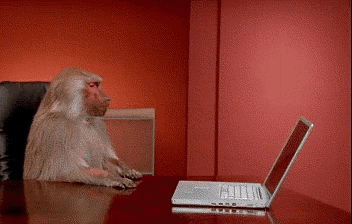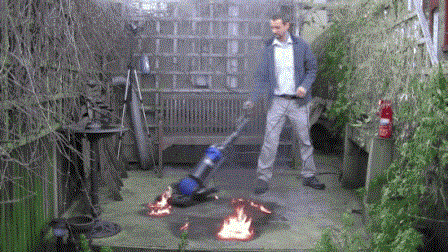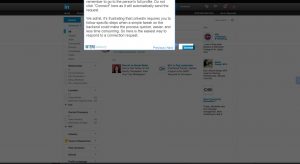For the last six months, Startup Hub has been doing webinars with the real gurus. We talked with Ashley Faulkes from Mad Lemmings, Andy Crestodina of Orbit Media, Dre Beltrami, the leader of Branded Solopreneur, and many others.
Not everything went smoothly, though…
All those “how to be a webinar pro and get millions of subscribers” guides promised us a sweet life and tons of traffic. As you might’ve guessed, the reality was different from our expectations.
Instead of loads of traffic generated through our awesome webinar content, we generated some mistakes…
Luckily, we’ve fixed most of them. Moreover, we’ve learned from every single mess-up we made, so we don’t make them again. And here are the lessons, so you don’t need to make webinar mistakes either.
Webinar tips based on a true story
I’m holding a phone in one hand and a case of hysteria in the other.
I’m running around the room and going nuts. I’m trying to reach my boss, or my colleagues, or at least the neighbor’s dog. Somebody has to fix this problem immediately.
What do you think has just happened? An earthquake?
No, it’s worse: our website is down.
And we have less than 24 hours left before our webinar. Tor Refsland, who’s working with us tomorrow, has sent us the third email in a row. And we have no answers.

(Me trying to fix our landing page the day before the webinar)
But look, I’m still here, and we’re still making webinars.
So now that we’ve made it through the hard part, here’s our list of shame: 18 webinar mistakes Startup Hub’s made.
And hell yeah, we dare to talk about them.
Your webinar is in trouble if…
1. If you use poor equipment
Jeff’s headphones fell into pieces like a minute after our first webinar was over. Obviously, they could have broken 10 minutes earlier and then I would have an even funnier story for this post.
My point: please, please, please (I can’t stress it enough) get a good webcam and a microphone.
You don’t need to go with ultra professional stuff, just buy something decent. Nobody wants to hear an echo while seeing that pixelated picture of yours.
2. If you pick up the wrong day
Wednesdays and Thursdays are webinar classics. Tuesdays are popular, too. Like, literally every article recommends hosting webinars in the middle of the week.
Statistics says they give you the maximum engagement. It makes sense: when you’re sitting in the office, webinars can be a good alternative to actually doing your job.
But the best webinar day really depends on your Google Analytics and the days your audience is most engaged. I mean, if your traffic peaks on Sunday, experiment with doing your webinars then.
3. If you do it at the wrong time
There won’t be any new revelations here. Webinars are live – your audience needs to be available for them. So to find out when they’re free and thinking about you:
1) Go to your analytics.
2) Check the countries where your website is popular.
3) Choose the time suitable for all of your fans.
In a nutshell, figure out the hours that work in as many time zones as possible where your audience is located. It might not be possible to catch everyone, but look for the most overlap.
To cut down on the math, we use the WorldTimeBuddy tool to convert it. And don’t forget to consider your own location.

4. If you don’t promote it on social media
Of course, we can’t imagine running a promotion without social media. If you have some money to spend, use paid ads. If you don’t, use your imagination.

Also, stay consistent. We made this huge mistake with our own social media promotion.
For each webinar, we tried to write 4–5 original and funny tweets. Because of Twitter’s characters limitations, we often sacrificed the name of the webinar to make a joke, so it seemed like we were talking about different webinars each time.
5. If you don’t do email marketing
“They” say you have to send two invitation emails — the first going out two weeks before the webinar, and one a week before. Then you have to send two final reminders, in rapid succession.
In reality, it depends on your audience. If you have a weekly newsletter, mention the webinar as the biggest upcoming event.
Statistics shows users are more likely to register for a webinar when it’s soon, like today or tomorrow, so those reminders are the most important things.
6. If you don’t coordinate with your guest for promotion
During our first webinar, the only thing our guest did for the promotion was a retweet. I think we were so happy to get such a guru for our webinar, that we just felt shy to ask for more. That was wrong.
Realize that your guests need this webinar no less than you do. So, coordinate to get as many people signed up as possible.
How many tweets will they write?
How many emails will they send?
Will they promote the event on their website?
Lay out and finalize these plans before you start promoting.
7. If your landing page doesn’t add any value
Okay, you made your audience come all the way from Twitter or their inbox to the landing page. It would be cruel to lose them now.
The first thing they see is the name of the webinar. Is it good?
Sure, it’s really difficult to think of something catchy and original, but it’s worth the effort. One time, we spent three days trying to come up with the perfect webinar name (BTW, the final version was Content Marketing: How to Sell Your Story).
Now that your audience has seen the name, how do they know whether you have any value to offer? Make the “you’ll learn during the webinar…” section as specific as possible – each sentence should be precise.
8. If registration forms on the landing page are incorrect
Proud moment: We were promoting our second webinar using a landing page with the wrong registration forms.
We were backing the release of e-books at the same time, and somehow the forms for ebook subscriptions replaced those for the webinar. So, when our visitors were pressing the button “Save my spot for the webinar,” they were offered to download some ebooks. What’s worse, we noticed this only 24 hours before the event was starting.
Those forms are the key to attendees. If you want your visitors to subscribe, make it as easy and understandable as possible. And don’t forget to check them from time to time. 😉
9. If you choose a topic that’s too broad
We struggled with this one. When you invite the “web idol” of yours, you want to ask them about everything. They’re good at SEO, email copywriting, content marketing, plus hundreds of other skills. But don’t – their answers will be too broad and too obvious.
Choose a narrow topic from the very beginning, and stay focused – don’t try to fit too many topics in. All questions should be short and to the point, even if there’s a temptation to delve into another topic.
10. If you don’t care about the background behind you
Keep it casual. You’re not doing The Late Show, so going full-on David Letterman and buying a cardboard with New York City skyline might be an overkill.
However, don’t keep it too casual: you don’t want your surrounding to be distracting. As we do our webinars from the office, we had such problems like a “fire exit” sign showing in the corner of the video, or the sound of heels clicking and people coughing as our co-workers were passing by.
We could have cleaned house a bit.
In fact, you have to think of your webinar as of a friendly talk. You want it to be homelike, so put up a few posters on the wall, get a comfy chair and have some daylight coming in (if you can).
11. If you don’t frame the shot well
Okay, it’s not as easy as it sounds. Six feet, four inches…That is the height of our host, Jeff – 6 feet 4 inches.
The camera should look right into his face, not higher or lower. So there was one webinar where we had to build a “billiard table+desk+laptop” contraption involving a billiards table, a desk, and a laptop so that we could film him at the right angle.
Now, if you’ve ever accidentally opened your phone’s front-facing camera, you know what I’m talking about: you look bad at that angle, and you don’t want to look like that for the whole webinar.
At Startup Hub, we always have pre-rehearsals via Skype, where we search for the best camera angle together.
12. If you don’t briefly promote yourself during the webinar
Don’t be afraid to show off. You have a great business and it deserves a mention or two – as long as the webinar isn’t an hour-long advertisement.
Add a branded title screen before the webinar, introduce yourself and your company at the beginning, and include a CTA on the final slide. Don’t forget about links to your website in the video description, too.
If the webinar is about the niche you work in, it would be weird not to mention your work once or twice anyway. Just don’t get too salesy. If it stinks, they’ll leave.
13. If you don’t collect questions from visitors
People will be watching your webinar because of the guests you’ve invited. They want to spend those 40 minutes with their favorite influencer, taking in wisdom and finding the answers to their burning questions.
Collect as many questions from your audience as you can (through Twitter or Facebook, or right on your landing page).
For different webinars, we had “What, in your opinion, is the best ready-made template out there?” or “How do I build my website?” And these questions worked. They were simple and needed for all. Try your best to put yourself in your viewers’ shoes (but they still know better what they need, don’t hesitate to ask).
14. If you’re hosting it wrong
Interact, for God’s sake! During a webinar, you don’t just ask a chain of rapid-fire questions. Mix up the content – include a presentation, some conversation, some Q&A.
Also, remember that if you use Google Hangouts like we do, the camera will sometimes switch to you randomly. So having a sip of coffee while your guest’s answering a question might not be the best idea. Try to look into the camera and don’t digress.
Moreover, don’t try to steal the spotlight — play host, banter a bit, and step down. The shorter the better. There will always be a huge temptation to clarify each question. But believe me, they understand or will ask for clarification.
15. If you don’t interact with the audience
Webinars are so popular because you can finish that yearly report or help your son with his homework while watching one. I bathed my cat during our last event (Jeff, if you’re reading this: I’m sorry).
It’s convenient for the viewer, but you want their full attention and distractions are everywhere. And if you don’t get them involved, that yearly report of theirs will be done by the end of the hour. You don’t want that.
You can engage your audience with the help of interactive questions, talking on social media, giving your viewer a task, or asking them about something. Images, videos, and music will do the trick, too. Just don’t do it all at once.
16. If you’re making it too long or too short
Aim for 60 minutes max. Brevity is the soul of wit. Or, in other words, nobody’s got time for every single thing you have to say.
One of our most popular webinars is called “Advanced SEO in 60 Minutes”. The formula is working: a complicated topic explained in a very short time brings great results.
17. If you don’t follow up after the webinar
Okay, the webinar was a blast. The great thing is that after it’s finished, you have a great marketing opportunity at your disposal.
First thing to do is send a follow-up email with a thank you and something useful — freebies, a recording, or the highlights from the webinar.
You can also write a blog post (or a guest post), based on the topic you discussed. Or write one about producing the webinars (that’s what I’m doing right now!).
18. If you’re doing the webinar all by yourself
There must be a person who will publish a social media post the second you’re on air.
Someone collecting the questions. Letting you know if you’re speaking too loudly or there’s an echo the speaker can’t hear.
Always have a backup in case you have problems that cannot be fixed immediately — like if the power goes out or if King Kong bursts into the building. Or if your cat is in dire need of a bath. That happens, too.

Final webinar planning tip
Now, while you can avoid the mistakes we made, you’ll likely make some on your own. And that’s okay. Be prepared to mess up – there are just so many things that can go wrong. What separates the great hosts is how they handle them and pick themselves back up.
Ten minutes before the webinar you’ll call your guest and, I bet you, everything will go down. Like, literally everything — the sound, the picture, your laptop and the whole world.
Don’t freak out. There’s only one way to fix it. Ready? Restart your computer. I know, I know, but it really helps in any emergency. Now, breath in. It’s showtime.
Business & Finance Articles on Business 2 Community
(54)






